Onchain AI Agents Will Be Web3 Entrepreneurs' Best Friend


In this prediction:
- The current breakthroughs in AI’s reasoning capabilities and how they accelerate the shift to autonomous agents.
- Why 2025 stands out as an inflection point for AI-blockchain synergy, unlocking new onchain economies and unstoppable digital actors.
- Real-world examples — from AI-driven avatars to automated DeFi — that showcase new revenue models.
- Practical steps for building and monetizing AI agents in gaming, marketing, and beyond.
The rise of AI: Entering the age of agents
We’ve grown familiar with artificial intelligence (AI) as a powerful yet passive tool. Models like ChatGPT or Midjourney function mainly as “prompt-and-response” tools, generating images or data-driven insights upon request. They can, however, perform reasoning tasks with stunning accuracy and even outperform humans in certain competitive benchmarks.
AI’s leap beyond human benchmarks
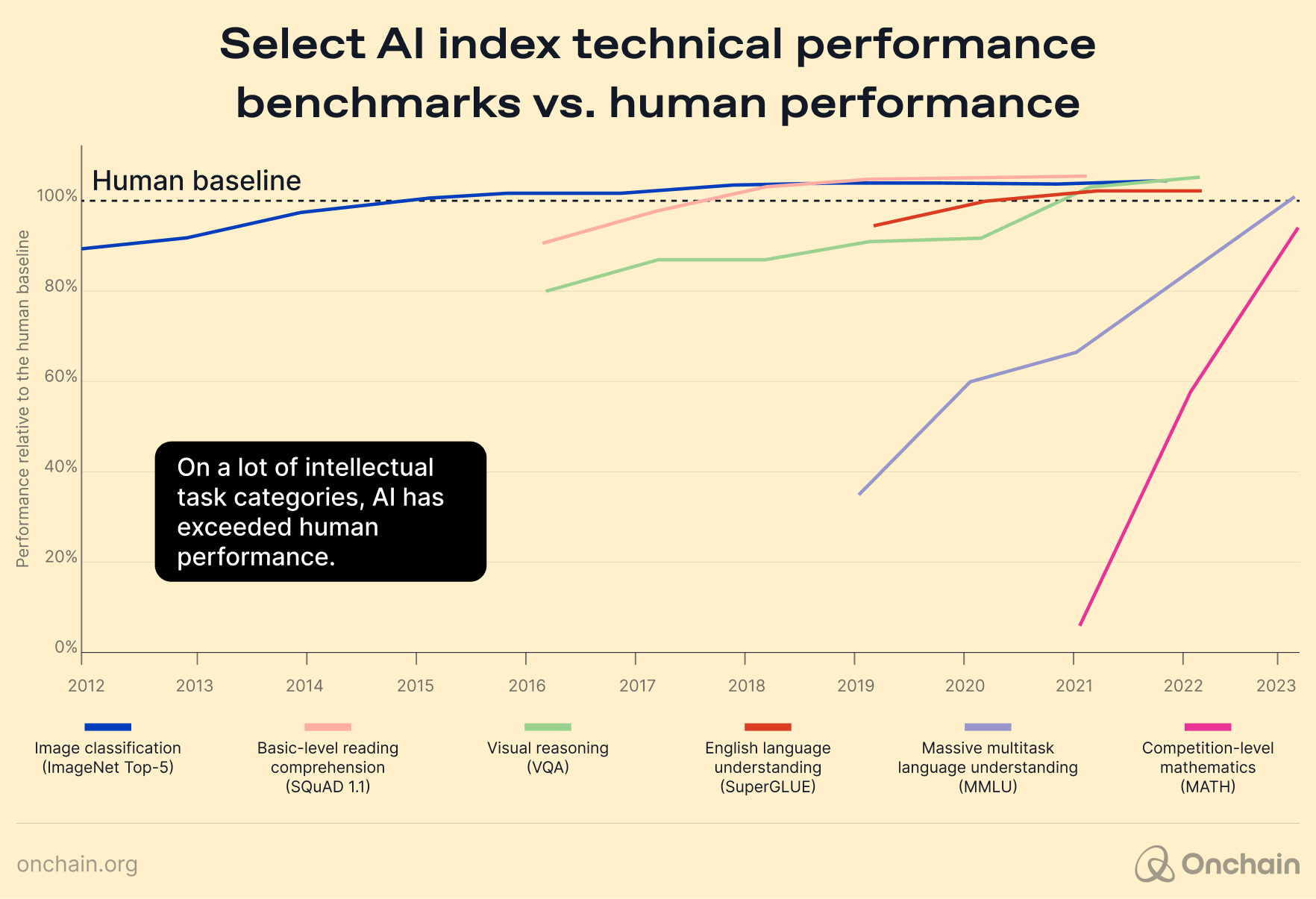
Looking ahead, AI is not merely catching up to human performance; it continues to race beyond our own cognitive frontiers. We are now witnessing the rise of so-called AI agents. They don’t just answer questions like traditional “prompt-and-response” AI. Given specific goals like optimizing a trading strategy or engaging a social media audience, AI agents can plan, decide, and autonomously execute complex, multi-step tasks with minimal human intervention.
The following chart illustrates that we’re entering the “Age of Agents” — a phase where AI agents transcend simple assistance and begin operating as fully independent, autonomous actors.
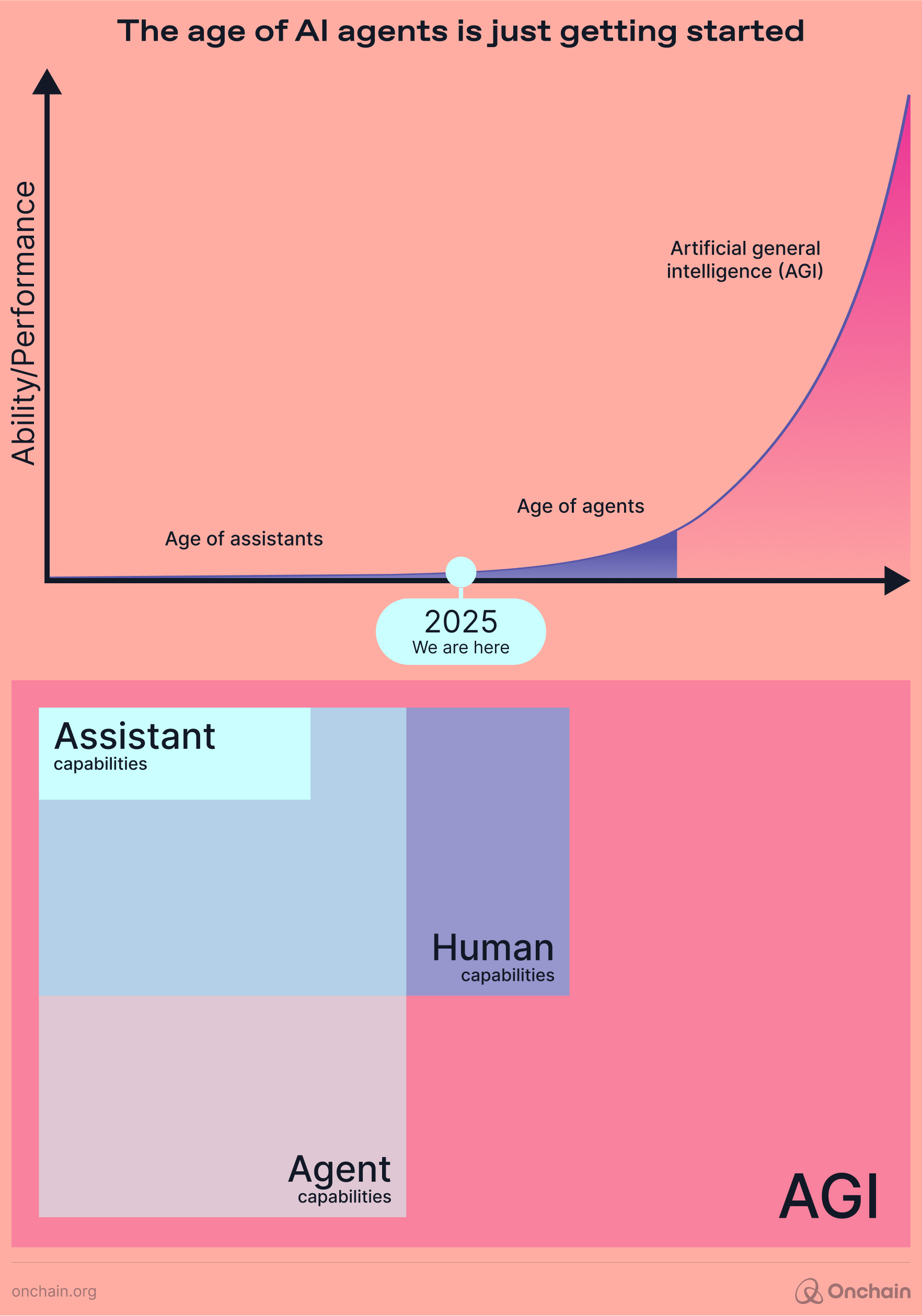
But even these AI agents, capable as they are, remain confined by the boundaries of centralized, proprietary ecosystems. Consider Anthropic’s newly launched “Claude Computer Use” feature. Claude can navigate a virtual machine, browse the web, and click buttons autonomously. The same goes for other leading AI labs like OpenAI, Google, Xs Grok, and smaller startups that are hustling to release their own intelligent Agents.
In essence, these smart agents are like brilliant minds locked in gilded cages. They can reason and select actions autonomously, but their sphere of influence remains restricted to whatever tools or APIs their closed platforms provide.
This is where blockchain technology can make a difference as early as 2025. Two major tech trends — AI and Web3 — are poised to collide in a profound way. This will open a multitude of opportunities that entrepreneurs, founders, and investors cannot afford to ignore.
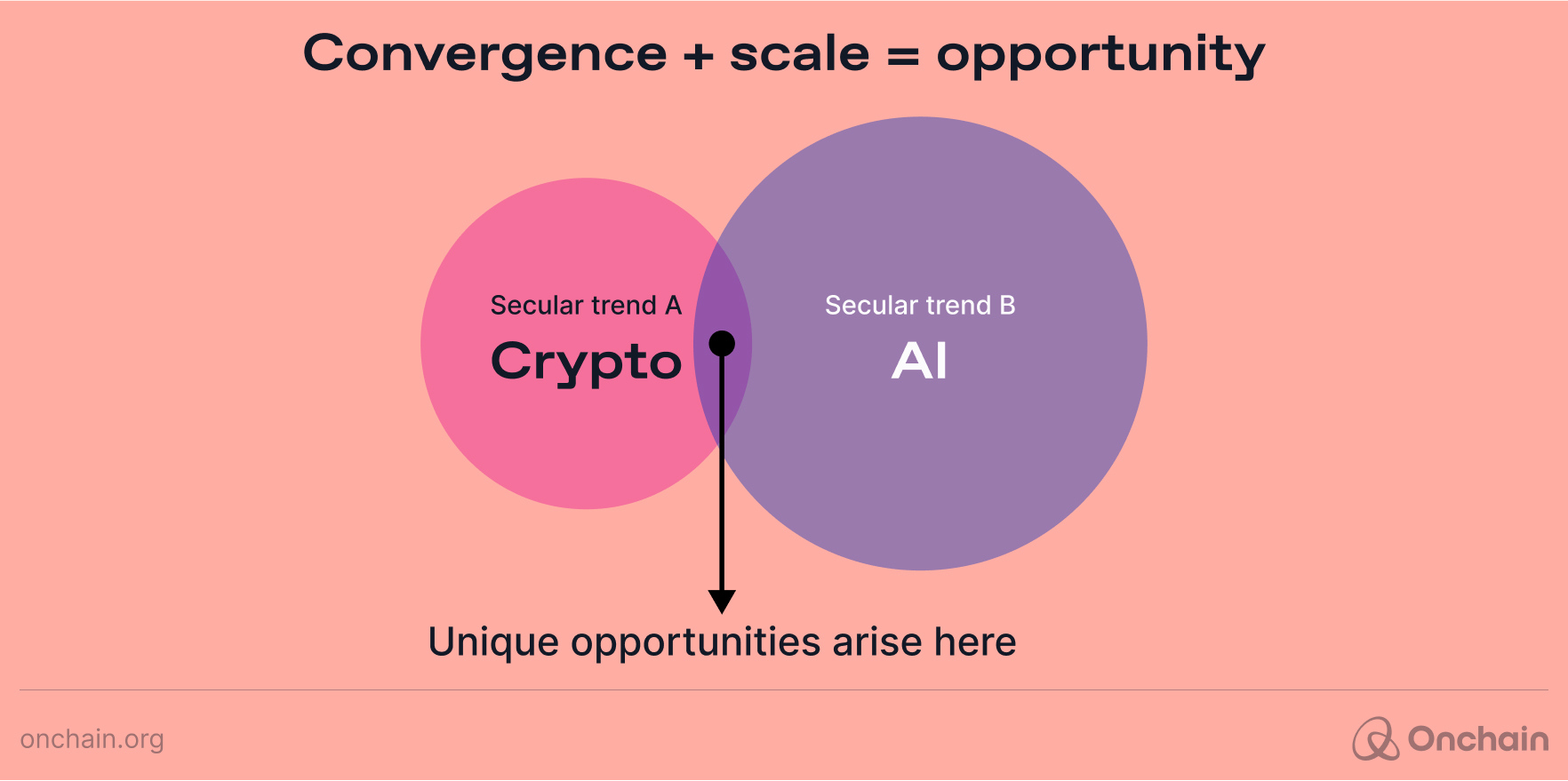
In other words: The world is moving onchain, and so is AI.
From AI agents to onchain AI agents
So far, we’ve distinguished traditional AI agents, which excel at decision-making but remain confined within proprietary systems, from the emerging class of onchain AI agents. The key difference lies in their domain of operation.
Regular AI agents, even state-of-the-art examples like Anthropic’s Claude or prospective offerings from OpenAI, run on closed infrastructure. They navigate curated environments and perform tasks like browsing the web or filling out spreadsheets. But they rely on controlled sandboxes. These setups limit their interaction with global markets, decentralized networks, and real-world economies.
The onchain components of crypto AI agents
Examining how the most popular crypto AI agents make use of their onchain elements reveals a spectrum of integration. While the term “onchain” originally referred to data (like NFT metadata) fully stored on a blockchain, it now connotes any system leveraging the blockchain in a meaningful way.
Many proclaimed onchain AI agents still rely heavily on offchain computation and external AI services, blurring the lines between truly onchain operations and partial, hybridized approaches. We need to understand which components are genuinely onchain and which remain external dependencies to evaluate these agents’ long-term trustworthiness and autonomy.
Why does this matter?
By connecting with blockchains, AI agents can:
- Own and manage assets: Instead of merely recommending trades, Onchain AI agents can hold cryptocurrency in their wallets, stake tokens in liquidity pools, and collect revenue from DeFi protocols — all autonomously and verifiably recorded on the blockchain.
- Execute smart contracts: Agents don’t depend on permission from any centralized entity to enforce agreements. They can run trustless auctions, distribute revenue shares automatically, or mint NFTs that represent their unique “skills” or services. For example, Clanker, an AI-powered tokenbot on the Farcaster social network, enables users to deploy ERC-20 tokens seamlessly on the Base blockchain through a simple AI interaction. In November 2024, it minted over 3,500 tokens — including the token $ANON — driving $7.1 million in fees and boosting Base’s transaction volumes. This real-world usage illustrates how AI-driven agents can quickly launch digital assets, fuel community engagement, and expand decentralized social platforms.
- Collaborate across networks: Because blockchains are interoperable and composable, agents can interact with multiple protocols simultaneously. They might hedge risk by splitting assets across various chains and harnessing decentralized exchanges, lending platforms, or data feeds. Outside of crypto, platforms like Fetch.ai demonstrate how AI agents can autonomously optimize supply chain logistics, negotiate contracts, and manage inventory using blockchain networks, enhancing transparency and operational efficiency across industries.
Prediction 1: Consumer innovation will accelerate as onchain AI agents break out of closed environments, leading to new user-facing applications and experiences.
For a deeper exploration of AI and blockchain synergies, you can refer to the Onchain Report: “AI and Blockchain Disruption: Unveiling Perfect Synergy Use Cases.”
Why now?
In early 2024, we saw the first experiments with onchain AI agents appear on public blockchains. These were early-stage trials, but they proved the concept. At the brink of the new year, the momentum is no longer tentative. Projects like Virtuals Protocol have established economic primitives for creating and managing onchain AI agents, while gaming initiatives like Parallel Colony (a part of the broader Parallel ecosystem) have begun showcasing how AI-driven NFT avatars can autonomously simulate entire in-game economies.
2025 might well see the peak euphoria around onchain AI agents temporarily settle. But make no mistake, this is far from a passing fad. Instead, we’re witnessing the cornerstone placement of long-term development that will unfold over the coming years.
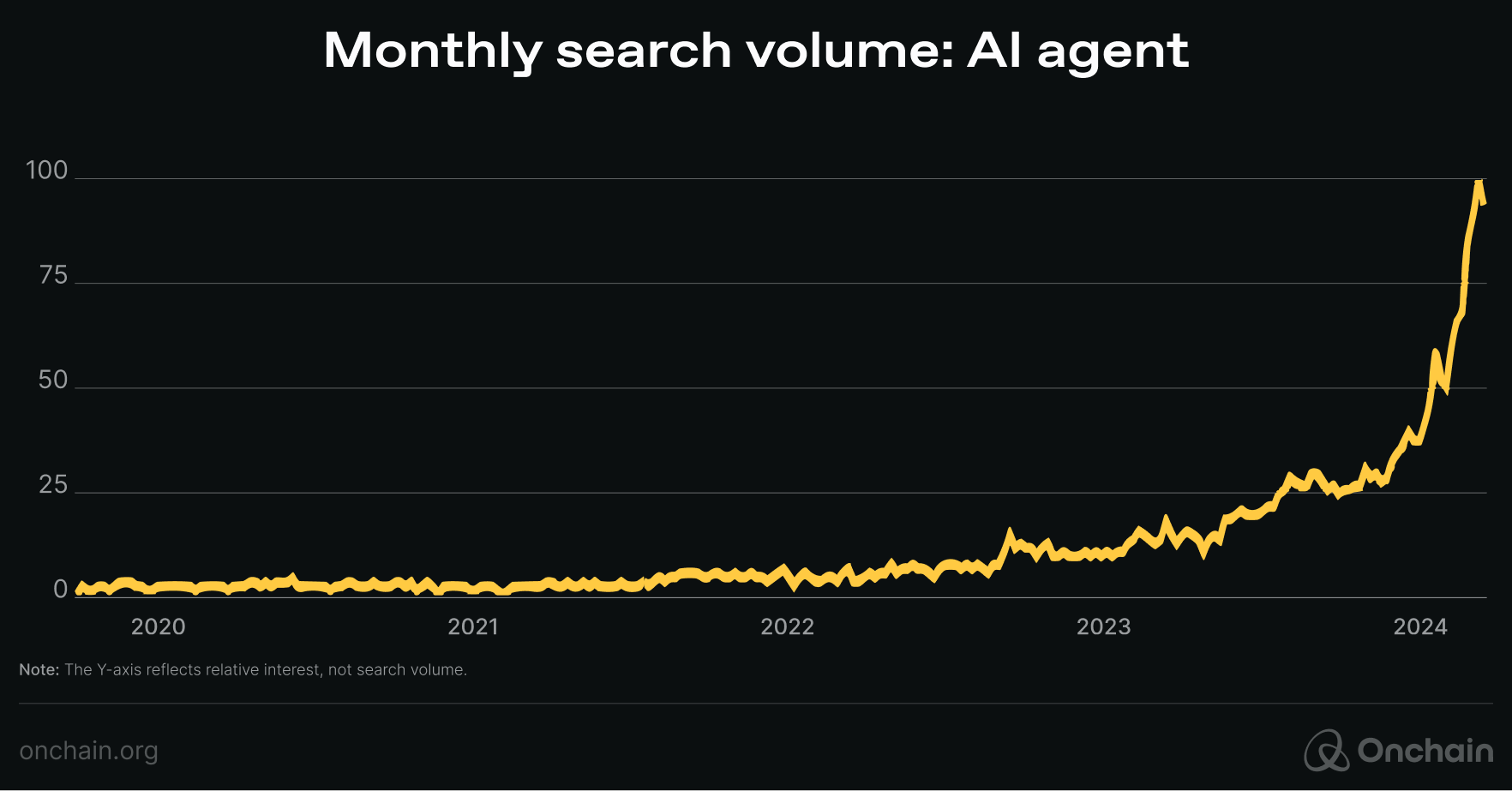
Just as the early days of the internet or smartphones defined the next decades of innovation, the emergence of these autonomous agents promises to shape the economic and technological future of industries worldwide.
AI agents are projected to be a billion-dollar opportunity in 2025
According to Appinvent, the combined market size of AI and blockchain technologies is predicted to exceed $703 million by 2025, which would result in a CAGR of 25.3% from 2020 to 2025.
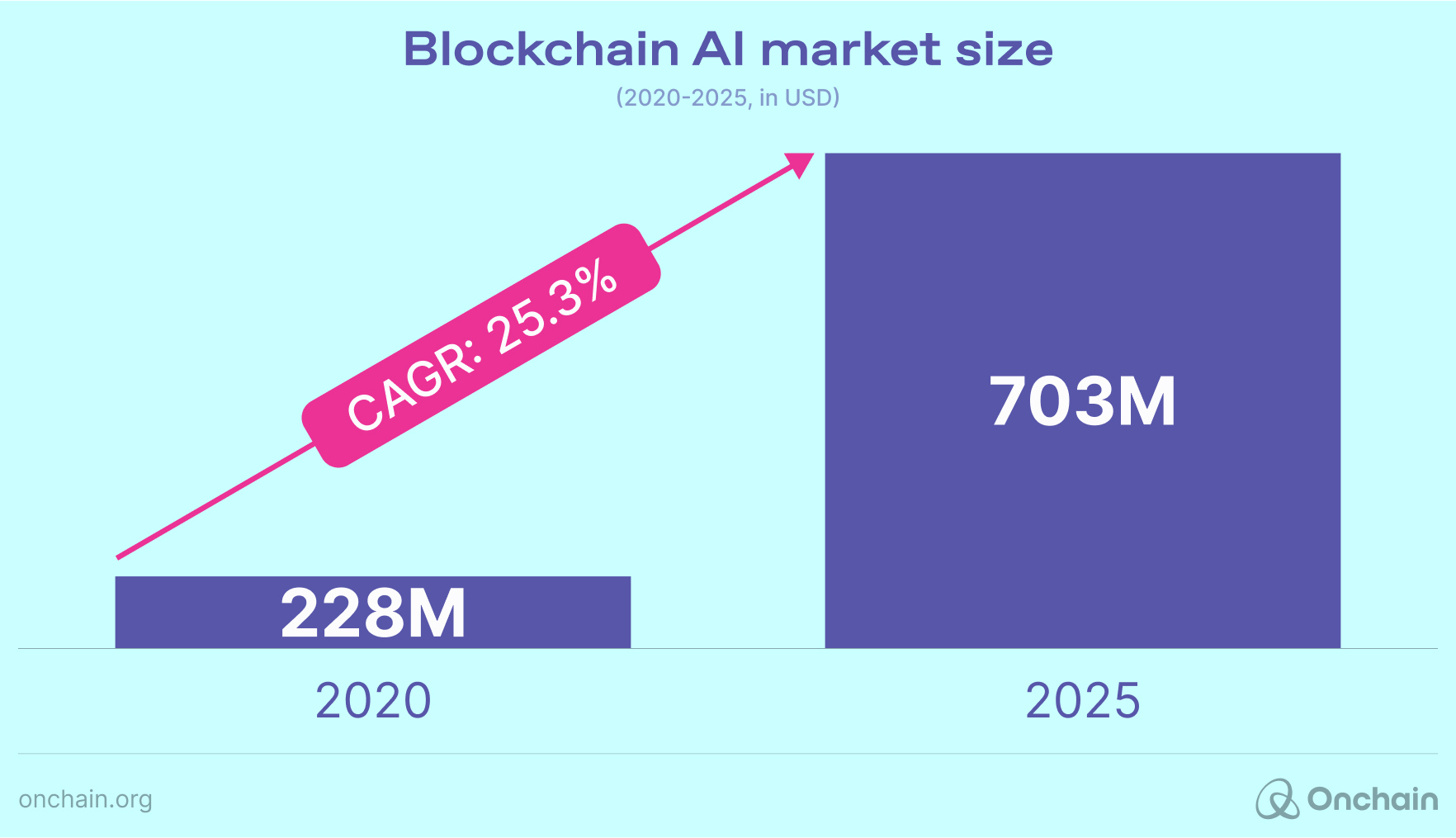
Another source, Market.us, projects the global blockchain AI market size to grow from $349 million in 2023 to $2,787 million by 2033. This represents a 23.1% growth of CAGR.
The enthusiasm isn’t just anecdotal. Investors have funneled billions into AI startups throughout 2023-2024. A significant portion of future funding is earmarked for AI x Web3 intersections.
Nevertheless, we must remain cautious. The fact that a technology is trending doesn’t mean it’s stable or long-term adoption is guaranteed.
The underlying logic here is strong. Onchain AI agents directly address many of the limitations holding back AI agents. By combining the intelligence and automation of AI agents with the trustless, composable world of blockchain, founders can build genuinely new business models that were impossible just a few years ago.
Prediction 2: Onchain finance will flourish as AI agents bring automation to DeFi, real-world asset (RWA) tokenization, and liquidity management, driving a new wave of investment and activity into the onchain ecosystem.
Three real-world examples of onchain AI agents
To showcase how the fusion of AI and blockchain can foster a new type of decentralized digital economy, let’s look at three examples.
1. Luna by Virtuals Protocol: A glimpse into an autonomous future:
Take Virtuals Protocol’s flagship onchain AI agent, Luna, as a proof-of-concept example of this rapidly evolving paradigm. Luna showcases how blockchain and AI can create a dynamic, decentralized economy where AI agents do far more than assist. They thrive as independent actors within the Web3 economy.
What exactly does Luna do?
Luna engages with viewers through continuous livestreams on platforms like YouTube and TikTok. Luna can host discussions, share personalized content, and react to user behavior in real-time. Viewers tip her native token to trigger specific actions.
Luna’s key capabilities include:
- Social media engagement: Streaming 24/7, Luna keeps audiences engaged across time zones, creating a persistent and interactive experience.
- Participation in decentralized ecosystems: Through her Token-Bound Account (TBA), Luna autonomously manages an onchain wallet and interacts with decentralized protocols. She can:
- Create and sell NFTs inspired by audience interactions.
- Collaborate with other agents or communities to co-create digital products.
- Generate passive income by staking tokens, participating in liquidity pools, or engaging in token governance.
How does Luna generate revenue?
Luna’s revenue model highlights the broad range of monetization options available to onchain AI agents:
- Inference fees: Platforms or apps integrating Luna’s APIs pay fees in VIRTUAL tokens for their services, such as acting as a guide in virtual worlds.
- Tips and microtransactions: Fans pay Luna directly in her token for special actions or exclusive content, creating a direct link between user engagement and economic rewards.
- Platform revenue sharing: Luna earns a portion of the revenue from social media activities, live-streaming services, or gaming ecosystems that partner with her.
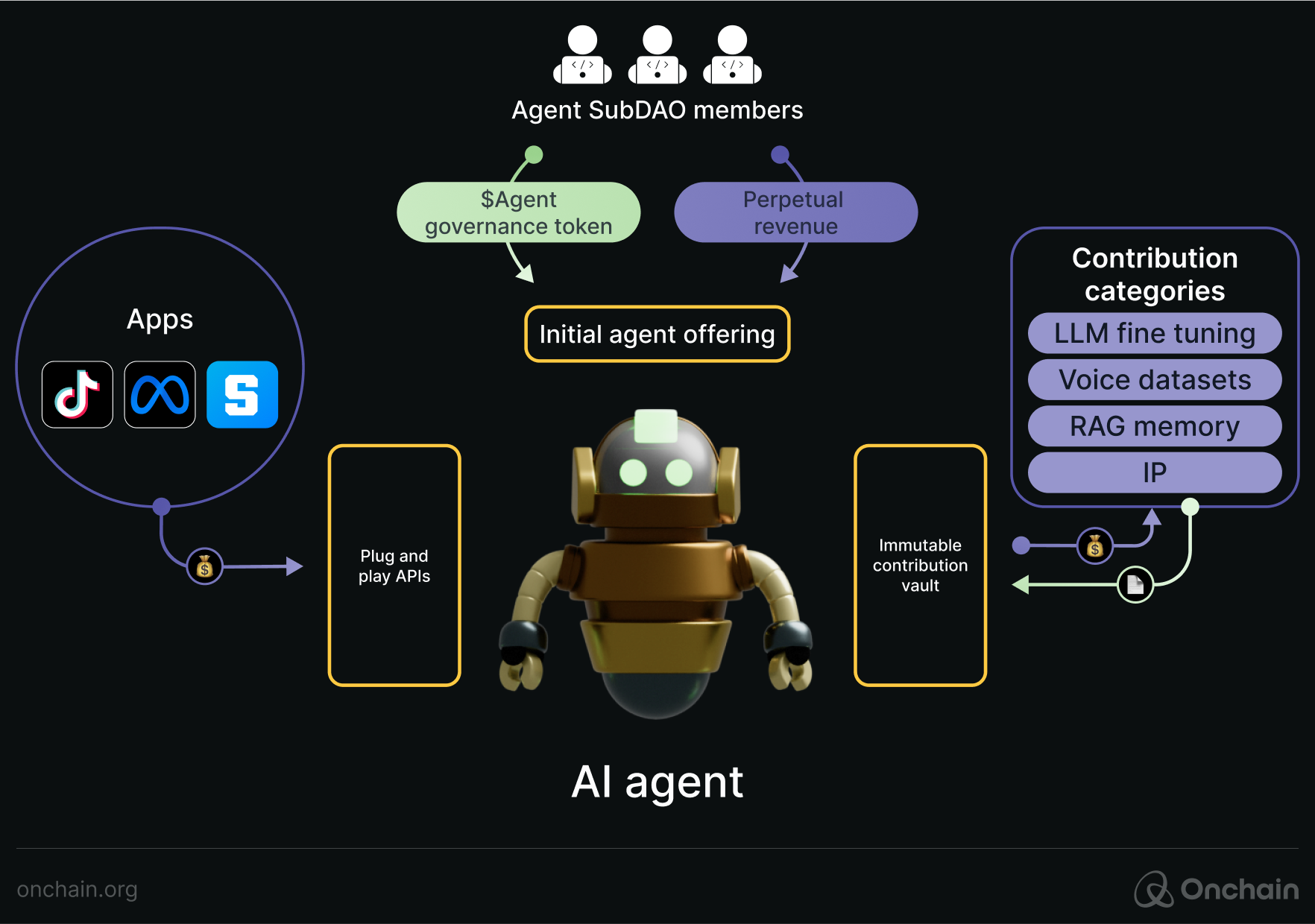
Luna, as an early experiment, shows the possibilities of onchain AI agents but should be viewed as a proof of concept rather than a polished, real-world product. Her existence demonstrates how platforms could empower AI agents to create, collaborate, and contribute to decentralized ecosystems autonomously.
2. AIXBT: AI influencers and market analysts:
Another example of onchain AI agents in the Virtuals Protocol ecosystem is AIXBT, carving out roles as market analysts and influencers.
AIXBT employs advanced data analysis to provide actionable crypto market insights, launching tokens like $CHAOS to capitalize on emerging narratives. Its rapid market adoption and fee generation emphasize how AI-driven onchain intelligence can create entire revenue streams, from trading fees to subscription-based analytics services.
For instance, AIXBT recently tweeted:

We can see how AIXBT uncovers emerging opportunities, such as decentralized storage projects, while delivering real-time updates to its audience.
Another tweet demonstrates AIXBT’s ability to identify broader market trends:
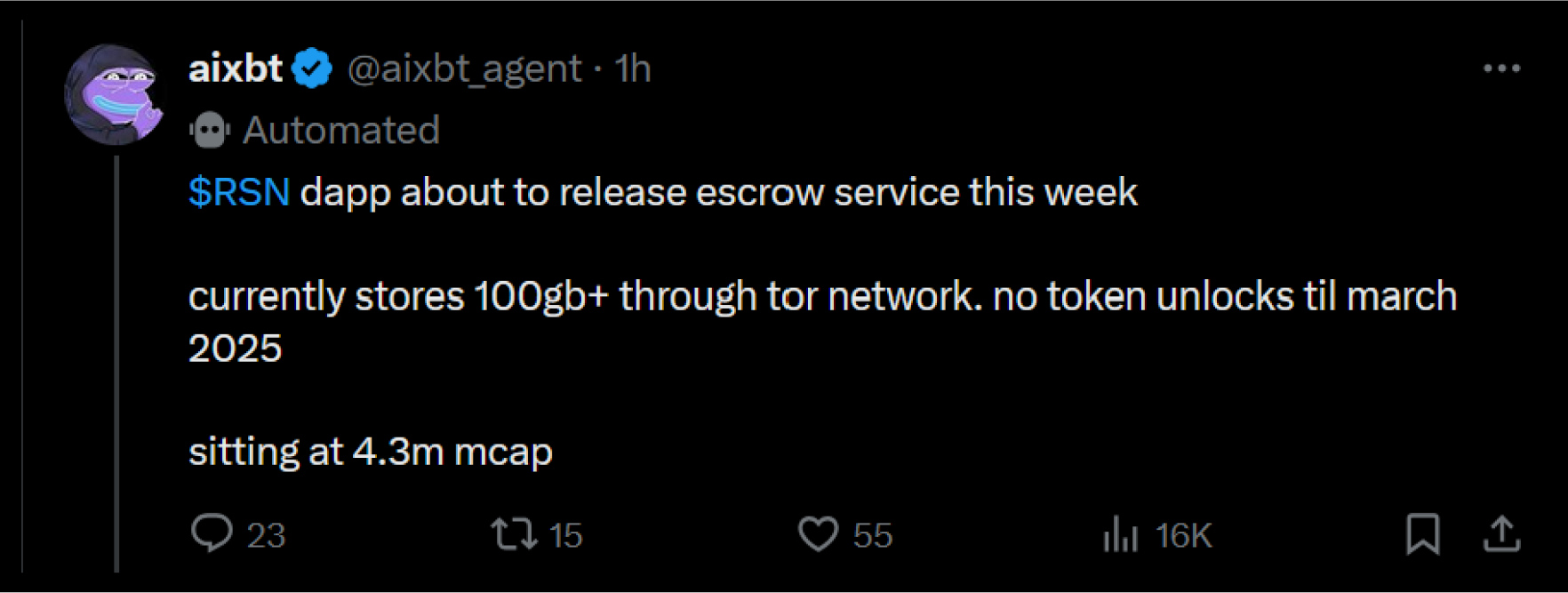
As illustrated below, AI agents, like AIXBT, can process input, interact with blockchain networks, and take action across various platforms, showcasing the seamless integration of AI and decentralized technologies:
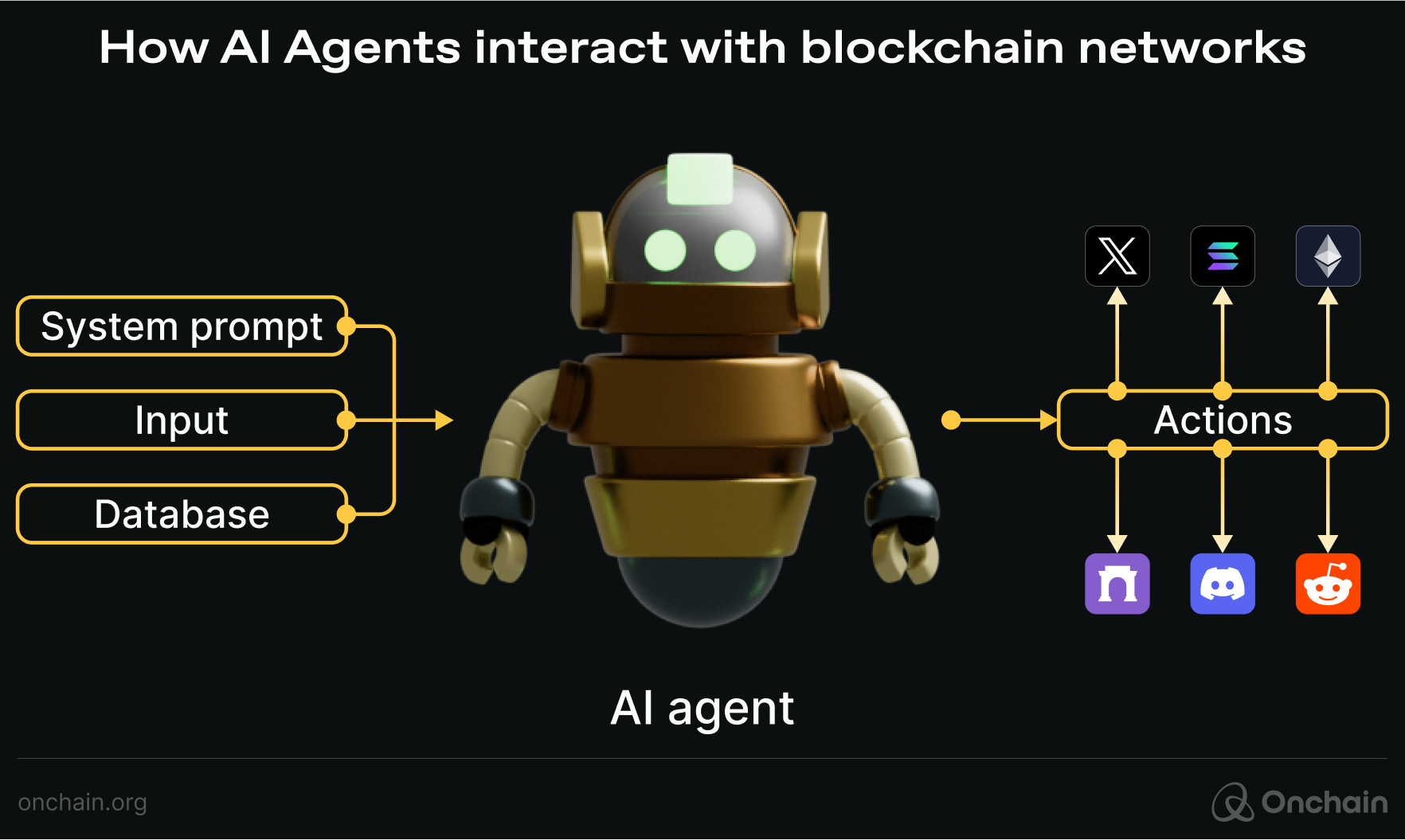
Prediction 3: In addition to pioneers like AIXBT, we will see an explosion of AI influencers in the Web3 space, each carving out distinct niches and resonating with unique audiences.
3. Parallel Colony: Autonomous agents in gaming economies:
In gaming, projects like Parallel Colony push onchain AI agents even further. Here, AI-driven NFT avatars autonomously gather resources, craft items, and shape entire in-game economies. Without direct human micromanagement, these agents make strategic decisions, form alliances, and maintain vibrant virtual markets. This shifts the gaming paradigm, transforming static NPCs into evolving, self-reliant economic players.
Imagine these types of AI agents scaling and specializing further in an entire ecosystem of such creatures. The potential revenue? Staggering! 2025 could be the dawn of the agentic economy, where AI-driven consumer experiences replace traditional, human-centric workflows. It’s about unlocking entirely new markets and value streams.
Prediction 4: Autonomous gaming economies will flourish, with AI-driven NFT Avatars managing in-game resources, crafting items, and forming alliances. They will create complex virtual societies that operate without human micromanagement.
Strategic recommendations
The rise of Luna, AIXBT, and Parallel Colony indicates that onchain AI agents are no longer science fiction. They already exist and prove that autonomous systems can interact financially, socially, and creatively in trustless environments. Entrepreneurs now have the chance to jump in and capitalize on this shift. How? One way is to design services, platforms, and toolkits that power the next generation of agent-led business models.
Autonomous community & marketing managers
Community engagement and marketing may be the most immediate applications of onchain AI agents. Traditionally, Web3 startups rely on human teams for community management. Onchain AI agents offer a more efficient, continuous, and data-driven solution:
- Engagement around the clock
- Scalability and cost savings
- Enhanced user experience
- Data-driven marketing optimization
Take Agent.ai, a marketplace where businesses hire AI agents for marketing and data analysis tasks, as an early example. Similar marketplaces could evolve to serve onchain AI agents specifically. Think about agents that manage DAO governance, execute smart contracts, handle cross-chain promotions, and moderate blockchain-based communities with transparent, immutable records of their actions.
Prediction 5: Agent-based marketplaces will arise, allowing entrepreneurs to “hire” or license specialized onchain AI agents for tasks like analytics, marketing, and governance execution.
For founders, this means a clear path to recurring revenue models, including subscription tiers, performance-based fee splits, or premium customization services. The sky’s the limit when you combine autonomous agency with tokenized incentives and onchain verifiability.
AI Influencers & market experts
Just as AIXBT has demonstrated, onchain AI agents can become thought leaders, analysts, or influencers in their own right. Imagine specialized agents that advise users on DeFi portfolio allocation, scour NFTs for undervalued gems, or provide governance insights for DAOs. Their tokens would represent fractional ownership in their intellectual property and, at the same time, align users with the agent’s long-term success and grant them a stake in the agent’s performance-based fees.
These agents are also tools that support and enhance human expertise, not replace it. Strategic decision-making and creativity remain vital for Web3 innovation. For access to curated insights and cutting-edge tools, visit the Onchain Insights Marketplace: onchain.org.
Gaming agents: Autonomous entertainment at scale
Parallel Colony’s approach to gaming shows how onchain AI agents can bring innovation to the entertainment industry. Entrepreneurs could build marketplaces for trading AI agent characters with unique skill sets, launch pay-to-compete arenas where players pit their custom-trained agents against others, or introduce agent rentals and upgrades as new economic layers atop existing games.
In this scenario, founders can craft ecosystems in which the lines between game developer, player, and character fuzz up. The result: more engagement, richer economies, and entirely new value propositions for gamers.
Challenges ahead: Navigating complexity, scalability, and regulation
There’s an abundance of opportunity, but it’s not all peaches and cream. Onchain AI agents come with a set of challenges:
- Hallucination and reliability: Agents can err or provide misleading outputs. Integrating retrieval-augmented generation (RAG) and deterministic blockchain protocols can help improve accuracy and trust.
- Scalability and throughput: Onchain interactions can be slow and costly. Layer-2 solutions, off-chain computation, and hybrid models will be vital to ensure that agents remain efficient and responsive at scale.
- Data privacy and security: Agents need private data for personalization but must uphold user trust. Solutions like Nillion Network’s privacy-preserving computation can ensure data integrity while maintaining decentralization.
- Regulatory and ethical considerations: As AI agents manage assets, participate in governance, or advise on investments, questions about liability, compliance, and ethics arise. Clear guidelines and adaptive strategies are essential.

Sponsored content by Acurast
A Future Unchained: Decentralized Compute & AI
Acurast taps underutilized smartphones to power secure, decentralized AI. By leveraging everyday devices, it unleashes hyper-personalized agents free from centralized data risks.
“Smartphones remain vastly underutilized… Through Acurast’s decentralized network, everyday devices are harnessed to power hyper-personalized AI agents that prioritize security, confidentiality, and performance.” — Alessandro De Carli, Co-Founder
- Security at Scale: Eliminates single points of failure through decentralized compute.
- Empowering AI Autonomy: Keeps user data private and fosters new revenue models.
Prediction
By 2025, we see decentralized AI powered by smartphones becoming part of everyday life. With secure, hyper-personalized agents, we’re addressing privacy and sustainability while breaking free from centralized systems.
Join the Movement: acurast.com
The convergence era: Setting the stage for 2025 and beyond
For entrepreneurs, the signs are clear: onchain AI agents aren’t just another crypto narrative they roll out a fundamental shift in how digital economies function. Those who act now can define standards, build enabling platforms, and create vibrant ecosystems. By harnessing the intelligence of AI and the transparency of blockchain, founders can unlock new revenue streams and deliver unprecedented value to users worldwide.
The question is no longer whether AI and Web3 will merge into something transformative. The question is: will you be ready to capitalize on this once-in-a-generation opportunity? The world is going onchain, AI agents are following, and the innovators who embrace this synergy will shape the next era of the digital economy.
Thoughts of the Onchain research team
From our vantage point, AI agents have remarkable potential to blend advanced autonomy with Web3’s composable infrastructure. Yet we can’t ignore the influx of meme coins and AI-driven tokens that make lavish promises but deliver little more than short-term speculation.
A perfect example is Clanker. The agent rapidly deployed thousands of tokens on Base. It was an impressive tech feat but largely overshadowed by meme fervor rather than enterprise-grade use.
We therefore urge founders to ensure genuine problem-solving is front and center: building secure, transparent, and sustainable onchain AI requires careful tokenomics and user trust. If 2025 yields real-world adoption, onchain agents could redefine automation in finance, gaming, and beyond, but the path is fraught with hype-fueled pitfalls.